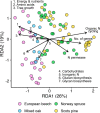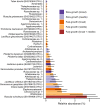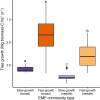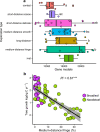Forest tree growth is linked to mycorrhizal fungal composition and function across Europe
- PMID: 35001085
- PMCID: PMC9038731
- DOI: 10.1038/s41396-021-01159-7
Forest tree growth is linked to mycorrhizal fungal composition and function across Europe
Abstract
Most trees form symbioses with ectomycorrhizal fungi (EMF) which influence access to growth-limiting soil resources. Mesocosm experiments repeatedly show that EMF species differentially affect plant development, yet whether these effects ripple up to influence the growth of entire forests remains unknown. Here we tested the effects of EMF composition and functional genes relative to variation in well-known drivers of tree growth by combining paired molecular EMF surveys with high-resolution forest inventory data across 15 European countries. We show that EMF composition was linked to a three-fold difference in tree growth rate even when controlling for the primary abiotic drivers of tree growth. Fast tree growth was associated with EMF communities harboring high inorganic but low organic nitrogen acquisition gene proportions and EMF which form contact versus medium-distance fringe exploration types. These findings suggest that EMF composition is a strong bio-indicator of underlying drivers of tree growth and/or that variation of forest EMF communities causes differences in tree growth. While it may be too early to assign causality or directionality, our study is one of the first to link fine-scale variation within a key component of the forest microbiome to ecosystem functioning at a continental scale.
© 2021. The Author(s).
Conflict of interest statement
The authors declare no competing interests.
Figures





Similar articles
-
Neighboring trees affect ectomycorrhizal fungal community composition in a woodland-forest ecotone.Mycorrhiza. 2008 Sep;18(6-7):363-74. doi: 10.1007/s00572-008-0185-2. Epub 2008 Aug 7. Mycorrhiza. 2008. PMID: 18685872
-
Lithological constraints on resource economies shape the mycorrhizal composition of a Bornean rain forest.New Phytol. 2020 Oct;228(1):253-268. doi: 10.1111/nph.16672. Epub 2020 Jun 25. New Phytol. 2020. PMID: 32436227
-
Ectomycorrhizas and tree seedling establishment are strongly influenced by forest edge proximity but not soil inoculum.Ecol Appl. 2019 Apr;29(3):e01867. doi: 10.1002/eap.1867. Epub 2019 Feb 27. Ecol Appl. 2019. PMID: 30710404
-
Atmospheric nitrogen deposition impacts on the structure and function of forest mycorrhizal communities: A review.Environ Pollut. 2019 Mar;246:148-162. doi: 10.1016/j.envpol.2018.11.074. Epub 2018 Nov 28. Environ Pollut. 2019. PMID: 30543941 Review.
-
The mycorrhizal-associated nutrient economy: a new framework for predicting carbon-nutrient couplings in temperate forests.New Phytol. 2013 Jul;199(1):41-51. doi: 10.1111/nph.12221. Epub 2013 Apr 17. New Phytol. 2013. PMID: 23713553 Review.
Cited by
-
Responses of soil fungal communities and functional guilds to ~160 years of natural revegetation in the Loess Plateau of China.Front Microbiol. 2022 Sep 2;13:967565. doi: 10.3389/fmicb.2022.967565. eCollection 2022. Front Microbiol. 2022. PMID: 36118195 Free PMC article.
-
Mycorrhizal symbiosis and the nitrogen nutrition of forest trees.Appl Microbiol Biotechnol. 2024 Sep 9;108(1):461. doi: 10.1007/s00253-024-13298-w. Appl Microbiol Biotechnol. 2024. PMID: 39249589 Free PMC article. Review.
-
Tree and shrub richness modifies subtropical tree productivity by regulating the diversity and community composition of soil bacteria and archaea.Microbiome. 2023 Nov 23;11(1):261. doi: 10.1186/s40168-023-01676-x. Microbiome. 2023. PMID: 37996939 Free PMC article.
-
Pervasive associations between dark septate endophytic fungi with tree root and soil microbiomes across Europe.Nat Commun. 2024 Jan 2;15(1):159. doi: 10.1038/s41467-023-44172-4. Nat Commun. 2024. PMID: 38167673 Free PMC article.
-
Ectomycorrhizal fungi: Potential guardians of terrestrial ecosystems.mLife. 2024 Jul 31;3(3):387-390. doi: 10.1002/mlf2.12127. eCollection 2024 Sep. mLife. 2024. PMID: 39359683 Free PMC article. No abstract available.
References
-
- Vittadini C. Monographia lycoperdineorum. Augustae Taurinorum, Torino, 1842.
-
- Frank B. On the nutrition of certain trees by underground fungi based on root symbiosis. Plant Biol. 1885;3:128–45.
-
- Harley J. Problems of mycotrophy. London: Academic Press; 1975.

